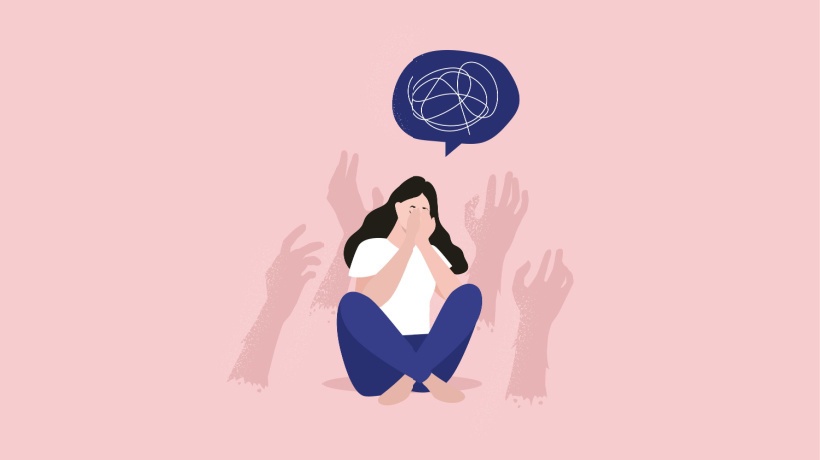What Most People Don't Know About Anxiety
The hectic rhythms of our daily lives have rendered anxiety an ever-present state for a great percentage of the world's population. While the set of potential risk factors may vary greatly, some common stressors can stem from a person's professional or personal life, the rapidly shifting socioeconomic and political circumstances, or the ambiguity of the future as a whole. As far as statistics go, a staggering 40 million adults suffer from anxiety disorders in the U.S. alone. At the same time, the percentage of those seeking treatment is considerably lower than half, at 36.9% [1]. As such, in a world where stimuli are everywhere and the changes around us happen at unprecedented rates, anxiety may have become an expected element of our lives.
In this part of our eLI Supports campaign, we are going to discuss some lesser-known aspects of anxiety that aren't always associated with its standard perception or its typical list of symptoms. By shedding light on these obscure facets of the condition, we hope to raise awareness and provide our audience with information to help them identify if they, or their loved ones, are struggling with anxiety.
Distinguishing Anxiety From Stress
Before delving into the covert aspects of anxiety, let's establish what anxiety really is. Both stress and anxiety are common emotional experiences with physical aspects, therefore they are often used interchangeably. However, they are distinct experiences, differing significantly in origin, duration, manifestation, and impact. To put it simply, stress is a short-term response to external stimuli that, while disruptive, can also be leveraged to one's benefit. As a temporary state, it can become a motivator to perform better or resolve an issue quicker; once the stressor dissipates or is resolved, the feeling of stress subsides considerably.
Anxiety, on the other hand, is quite pervasive and doesn't dissipate when the stressor is neutralized. Often described as a long-lasting, permeating feeling of worry or imminent doom, anxiety persists even if there isn't an explicit trigger. It is accompanied by physical, behavioral, and emotional symptoms that pose a threat to a person's overall well-being. Moreover, there are different kinds of anxiety disorders, [1] which describe persisting symptoms with high intensity for extended periods of time. As such, anxiety may have disruptive consequences on various facets of an individual's life, making the need to distinguish stress from anxiety vital.
5 Unexpected Aspects Of Anxiety
Anxiety is considered an expected response to a variety of persisting stressors. But the more frequently or acutely it is experienced, the more attention should be paid. While restlessness or nervousness are prevalent symptoms of the condition, there are other lesser-known signs that manifest due to anxiety. Learning to recognize these signs in ourselves or in our loved ones can help us become proactive in addressing them. Also, by staying informed and raising awareness, we can identify our triggers and seek help to neutralize them more precisely.
1. Fatigue
This is a subtle facet of anxiety that many people can easily dismiss. Sure, fatigue may result from long hours spent at work or commuting but it can also be an indicator that you're anxious or overwhelmed. It doesn't matter if you're getting enough sleep or have just returned from vacation; anxiety-induced fatigue significantly reduces our energy supply, making us feel exhausted no matter how much we try to rest. Persisting exhaustion is cause for further inspection, as it disrupts our daily routine and can become an obstacle to living full lives.
2. Mental Fog And Memory Gaps
While memory problems or brain fog may result from a variety of factors, they are actually quite common in people with anxiety. Often overlooked, both mental fog and memory gaps can create significant challenges in the day-to-day. Having trouble concentrating or being preoccupied with whirring thoughts can make us forget to be present in the moment. This kind of trance hinders the retention of the information we collect as we go about our day. Hence, beware; this is not mere daydreaming—if unchecked, brain fog can lead to memory gaps and even episodes of dissociation or depersonalization. Gaps in memory can be prevalent among people with anxiety, which can become a significant hindrance, intervening in their personal and professional journeys.
3. Perfectionism
Anxiety can also manifest as perfectionism. Constantly trying to bring our best selves to everything that we do or to anticipate and address hurdles as they come may chisel away at our innate resilience. Conscientiousness is a great asset to have—but only in moderation. When in abundance, perfectionism creates an endless loop of constantly trying to perform and excel. This, in turn, may result in harsher self-criticism, unsustainable timeframes, and other negative consequences, all actually stemming from unreined anxiety. It's best to appreciate what you are able to bring to the table instead of trying to surpass your limits.
4. Dissociation
Often hand-in-hand with brain fog, anxiety can cause feelings of dissociation or depersonalization. The "out-of-body" experience of these symptoms can easily be misinterpreted as forgetfulness or apathy. However, both dissociation and depersonalization are signs of anxiety that significantly affect a person's day-to-day. Nothing induces the need for escapism as much as the uncomfortable state of being anxious. Losing touch with reality or with one's self can have major consequences and endanger not only a person's routine but also one's safety and well-being. Along with the physical aspects, dissociation is one of the most severe symptoms anxiety can cause.
5. Physical Manifestations
When discussing the topic of anxiety, it's not uncommon for people to mention its physical aspects. Restless movement, muscle tension, sweaty palms, or trembling hands are often highlighted in conversations related to anxiety disorders. Nevertheless, anxiety can bring other physical manifestations that deviate from what we would normally associate with the condition. Digestive or gastrointestinal issues, circulation problems, and lightheadedness are among some of the lesser-known aspects of anxiety that, when persisting, may require further consultation with a professional.
Additional Signs And Symptoms
The above facets aren't an exhaustive list of potential behavioral, physical, or mental manifestations of anxiety. There are many more aspects of anxiety one needs to keep an eye on. To mention some:
- Disrupted sleep or oversleeping
- Indecisiveness
- Excessive need for control
- Cold hands or feet
- Nausea
- Hot flashes
- Chest pain
- Shortness of breath or hyperventilation
While some may experience these signs less acutely, it's always important to put your well-being first. If you recognize any of these signs, it might be time to look further into it. Feeling "off" for an extended period of time may be an indicator that you need to prioritize your own welfare.
World Mental Health Day
To mark World Mental Health Day on October 10, we have attempted to bring attention to some of the lesser-known aspects of anxiety that millions of people experience. We consider it vital to start a dialogue that raises awareness and encourages people to provide or seek a helping hand.
Remember, anxiety doesn't discriminate; it doesn't matter if you're a CEO or a young student fresh out of high school. It's a condition that is more or less reinforced by the fast-paced day-to-day, as well as a variety of other factors that amplify its presence. Yet, as the world keeps shifting around us, it's essential that we stay focused on our well-being. It's only then that we will be able to truly conquer any challenges that come our way. If you're struggling with anxiety, or recognize the aspects that we've included in our list either in yourself or in others, consider reaching out to a loved one or a professional.
eLI Supports
This post honors Ian Patrick Crabill, whose compassion knew no bounds. STOP THE BLEED® was a cause near and dear to him, and we're now carrying on the mission to raise awareness and help save lives in his memory. Ian never left home without four tourniquets because "You have four limbs," and he once offered medical aid at the scene of a car accident while first responders were en route. He battled anxiety from early childhood, and on March 4, 2023, he took his own life. In his 19 years, he set an example for us all on how to selflessly care for others and venture outside our comfort zones whenever the opportunity comes along. You can learn more about the training program that STOP THE BLEED® provides by visiting their website.
References
[1] Facts & Statistics | Anxiety and Depression Association of America, ADAA








